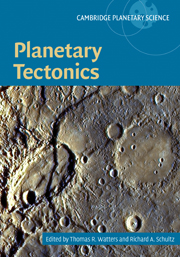Book contents
- Frontmatter
- Contents
- List of contributors
- Preface
- 1 Planetary tectonics: introduction
- 2 The tectonics of Mercury
- 3 Venus tectonics
- 4 Lunar tectonics
- 5 Mars tectonics
- 6 Tectonics of small bodies
- 7 Tectonics of the outer planet satellites
- 8 Planetary structural mapping
- 9 Strength and deformation of planetary lithospheres
- 10 Fault populations
- Index
- Plates
- References
6 - Tectonics of small bodies
Published online by Cambridge University Press: 30 March 2010
- Frontmatter
- Contents
- List of contributors
- Preface
- 1 Planetary tectonics: introduction
- 2 The tectonics of Mercury
- 3 Venus tectonics
- 4 Lunar tectonics
- 5 Mars tectonics
- 6 Tectonics of small bodies
- 7 Tectonics of the outer planet satellites
- 8 Planetary structural mapping
- 9 Strength and deformation of planetary lithospheres
- 10 Fault populations
- Index
- Plates
- References
Summary
Summary
Solar system bodies smaller than ~200 km mean radius have little internal heat energy to drive tectonics typical of the terrestrial environment. Short-lived high stresses from impacts or long-term, low stresses are the primary shapers of these bodies. This chapter provides an overview of the basic features and processes that can be regarded as small-body tectonics.
Introduction: types of small bodies, their properties, and environments
Small bodies of the solar system are here taken to be those too small for gravitationally driven viscous relaxation to have determined their shapes. This definition restricts consideration to objects less than about 150 km radius (Johnson and McGetchin, 1973; Thomas, 1989). Within this definition are some dozens of satellites of planets, and thousands of asteroids, cometary nuclei, and Centaur and Kuiper-Edgeworth belt objects (Binzel et al., 2003). As of early 2006, spacecraft have visited small satellites, asteroids, and four cometary nuclei (Figure 6.1). Resolved information on these objects is dominated by the NEAR mission that orbited and then landed on 433 Eros, by images of the Martian satellites, Phobos and Deimos, and by images of comet Tempel 1 (A'Hearn et al., 2005). Radar images of near-Earth objects are beginning to show some details of asteroid shapes and surface features (Hudson et al., 2003). Meteorites provide small samples of asteroids, though only in the case of asteroid Vesta (larger than the size range considered here) are there positive connections of meteorite samples to a specific object (Binzel et al., 1993; Keil, 2002).
- Type
- Chapter
- Information
- Planetary Tectonics , pp. 233 - 263Publisher: Cambridge University PressPrint publication year: 2009



